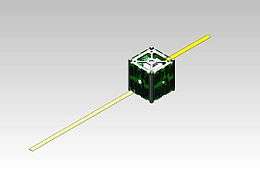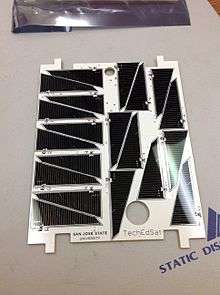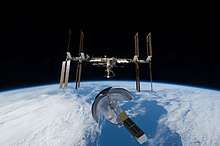TechEdSat
The Technological and Educational Satellite (TechEdSat) program is a series of CubeSats built by San Jose State University and University of Idaho students in partnership with Ames Research Center and ÅAC Microtec. These satellites have tested communication technology for smallsats, and have contributed to the development of the Small Payload Quick Return (SPQR) concept.
TechEdSat

The first TechEdSat (later renamed "TechEdSat-1" or "TES-1")[1][2][3] was a 1-U Cubesat designed to evaluate Space Plug-and-play Avionics (SPA) designed in Sweden by ÅAC Microtec. It was also originally intended to perform a communications experiment utilizing the Iridium and Orbcomm satellite phone network,[4] although this function was disabled before launch.[5] TechEdSat was deployed into orbit from the International Space Station on 4 Oct 2012. It reentered to atmosphere on 5 May 2013.[6]
Operators: San Jose State University, University of Idaho, JAXA, ÅAC Microtec, NASA
SATCAT no.: 38854
COSPAR ID: 1998-067CQ
Orbital Parameters[8]
- Perigee: 402 kilometres (250 mi)
 TechEdSat Engineering Development Unit
TechEdSat Engineering Development Unit - Apogee: 422 kilometres (262 mi)
- Inclination: 51.65 degrees
- Period: 92.80 minutes
- Epoch: 9 October 2012
Hardware[9]

- Quake Global Q1000 Modem ( Orbcomm ) (Deactivated)
- Quake Global Q9602 Modem ( Iridium ) (Deactivated)
- Stensat Radio Beacon
- 4x nanoRTU (ÅAC Microtec)
- Main Power Distribution Board (ÅAC Microtec)
- RTU Lite (ÅAC Microtec)
- 2 meter band Monopole Antenna
- 70cm band Monopole Antenna
- 1600 MHz Patch Antenna
- Pumpkin, Inc. 1U Skeletonized CubeSat Structure
- Canon BP-930 Lithium-ion battery

Specifications
- Dimensions: 113.5 mm x 100 mm x 100 mm
- Mass: 1.2 kg (2.6 lb)
- Power Consumption (Safe Mode): 0.35 W
- Power Consumption (Safe Mode, Stensat Transmitting): 3.4W
- Power Consumption (Nominal Mode): 3.965W
- Power Consumption (Q1000 Transmitting): 27.125W
- Power Consumption (Q9602 Transmitting): 10.49W
- Power Consumption (Nominal Mode, Stensat Transmitting): 7.015W
- Solar Array (Average): 1.229W
- Power Storage: 17 Wh
Launch
TechEdSat was launched from Pad 2 of the Tanegashima Yoshinobu Launch Complex on 21 July 2012, at 02:06 UTC[10], aboard Kounotori 3 atop an H-IIB launch vehicle. Kounotori 3 carried the satellite, along with the Raiko, We-Wish, Niwaka and F-1 spacecraft, to the International Space Station, from where it was deployed via the JAXA J-SSOD deployer, from the Kibo module on 4 Oct 2012 at 15:44:15.297 UTC.[11]
Beacon Packet Format
TechEdSat-1 transmitted a heartbeat packet over amateur radio every 4 seconds. These packets are 122 ASCII character AX.25 packets. Amateur band radio frequency is 437.465 MHz.[12]
Two consecutive 12 bit raw ADC Data values are parsed into one 3 byte chunk in order to save data space.
TechEdSat-2
TechEdSat-2 was planned as a 6U CubeSat, a collaboration between ÅAC Microtec in Sweden and NASA Ames.[13]
An Iridium transceiver flew aboard the PhoneSat v1b CubeSat as the TechEdSat-2 mission, separate from the spacecraft originally planned as TechEdSat-2.[14]
PhoneSat v1b (TES-2) SATCAT no.: 39142
PhoneSat v1b (TES-2) COSPAR ID: 2013-016A
PhoneSat v1b (TES-2) NSSDCA ID: 2013-016A[7]
PhoneSat v1b (TES-2) Orbital Parameters[8]
- Perigee: 218 kilometres (255 mi)
- Apogee: 228 kilometres (258 mi)
- Inclination: 51.64 degrees
- Period: 88.95 minutes
- Epoch: 24 April 2013
TechEdSat-3p
TechEdSat-3p was a 3U CubeSat that was launched to the International Space Station on 20 November 2013 from Tanegashima, Japan on the HTV-4 International Space Station cargo resupply mission and subsequently deployed into orbit using the JEM-Small Satellite Orbital Deployer. It tested an exo-brake to demonstrate a passive deorbiting.[15]
Operators: SJSU, University of Idaho, NASA Ames Research Center
SATCAT no.: 39415
COSPAR ID: 1998-067DD
NSSDCA ID: TECHEDS3P[7]
Orbital Parameters[8]
- Perigee: 410 kilometres (255 mi)
- Apogee: 415 kilometres (258 mi)
- Inclination: 51.65 degrees
- Period: 92.81 minutes
- Epoch: 20 November 2013
TechEdSat-4
TechEdSat-4 was a 3U CubeSat mission developed, integrated, and tested at NASA Ames in partnership with student interns from San Jose State University in California and the University of Idaho in Moscow, Idaho. The objective of the TechEdSat-4 mission was to demonstrate new technologies including satellite-to-satellite communications and an upgraded Exo-Brake device to demonstrate a passive deorbiting. TechEdSat-4 was launched as a secondary cargo payload on the Cygnus CRS Orb-2 ISS resupply mission. The launch vehicle was the Orbital Sciences Corporation Antares-120, launching from the Mid-Atlantic Regional Spaceport on Wallops Island, VA on 13 July 2014.[16] TechEdSat-4 was deployed from the International Space Station via the NanoRacks CubeSat Deployer on 4 March 2015.[17][18]
Operators: SJSU, University of Idaho, NASA Ames Research Center
SATCAT no.: 40455
COSPAR ID: 1998-067FY
Orbital Parameters[8]
- Perigee: 393 kilometres (244 mi)
- Apogee: 402 kilometres (250 mi)
- Inclination: 51.64 degrees
- Period: 92.50 minutes
- Epoch: 5 March 2015
TechEdSat-5

TechEdSat-5 was a 4 kg, 3.5U CubeSat that was launched on 9 December 2016 aboard the HTV-6 cargo resupply spacecraft, and was deployed from the International Space Station at 18:20 UTC on 6 March 2017.[19] It was the first satellite in the TechEdSat program to include a modulated Exo-Brake that was could adjust the amount of atmospheric drag on the spacecraft, enabling a targeted re-entry.[20] The TechEdSat-5 Exo-Brake was cross-shaped, made of mylar, and used a combination of mechanical struts and flexible cords.[21] Its surface area was approximately 0.35 square metres.[19] A ‘Cricket’ Wireless Sensor Module (WSM) was included with TechEdSat-5.[22] The satellite reentered the atmosphere on July 29, 2017 after successfully operating for 144 days.[21]
Operators: SJSU, University of Idaho, NASA Ames Research Center
SATCAT no.: 42066
COSPAR ID: 1998-067LB
Orbital Parameters[8]
- Perigee: 397 kilometres (247 mi)
- Apogee: 408 kilometres (254 mi)
- Inclination: 51.64 degrees
- Period: 92.61 minutes
- Epoch: 8 March 2017
TechEdSat-6
TechEdSat-6 was a CubeSat that was launched at 12:19 UTC on 12 November 2017 aboard the Cygnus CRS-8 cargo resupply mission to the International Space Station.[23][24] It was deployed from the NanoRacks Nanolauncher on 20 November 2017.[25] It has since reentered the atmosphere.[8]
Operators: SJSU, University of Idaho, NASA Ames Research Center
SATCAT no.: 43026
COSPAR ID: 1998-067NK
Orbital Parameters[8]
- Perigee: 397 kilometres (247 mi)
- Apogee: 406 kilometres (252 mi)
- Inclination: 51.65 degrees
- Period: 92.59 minutes
- Epoch: 21 November 2017
TechEdSat-7
TechEdSat-7 is a 2U CubeSat that is intended to test a High Packing Density Exo-Brake. It is planned to launch on Virgin Orbit's LauncherOne as part of NASA's ELaNa program. It will fly with a CubeSat Identity Tag (CUBIT), a Radio Frequency Identification (RFID) tag developed by DARPA to assist in future identification of satellites.[26]
Operators: SJSU, University of Idaho, NASA Ames Research Center
TechEdSat-8
TechEdSat-8 is a 1x6U CubeSat that will include a Hot Exo-Brake and an ablation device. It is planned to launch with the Cygnus NG-10 cargo resupply mission to the International Space Station as part of the ELaNa program.[27]
Operators: SJSU, University of Idaho, NASA Ames Research Center
Orbital Parameters (approx. expected)[27]
- Perigee: 400 kilometres (249 mi)
- Apogee: 400 kilometres (249 mi)
- Inclination: 51.6 degrees
- Period: 92 minutes
TechEdSat-10
TechEdSat-10 is a 3U CubeSat that was selected in 2018 to launch as part of the ELaNa program.[28]
Operators: SJSU, University of Idaho, NASA Ames Research Center
SOAREX flights
Several investigations for the TechEdSat program have been flown on Sub-Orbital Aerodynamic Re-entry Experiments (SOAREX) sounding rockets flights.
SOAREX-6 flew 27 November 2008 on an ATK Sub-orbital/Orion 50xl sounding rocket.
SOAREX-7 flew 28 May 2009 aboard a Terrier-Orion sounding rocket launched from Wallops Flight Facility (WFF) in Virginia. A TDRV (Tube Deployed Re-entry Vehicle) was successfully tested after the flight reached its apogee of 134 km.[3]
On SOAREX-8, which launched on a Terrier Black-Brant suborbital sounding rocket, a wireless sensor module, a camera, various communication devices, and a full Exo-Brake were tested.
On SOAREX-9, a wireless sensor module, a camera, and various communication devices were tested.[29]
References
- ↑ http://space.skyrocket.de/doc_sdat/techedsat.htm
- ↑ https://www.nasa.gov/sites/default/files/atoms/files/techedsat5-factsheet-508-april2017.pdf
- 1 2 https://web.archive.org/web/20161229151730/https://solarsystem.nasa.gov/docs/1_04_An%20Overview%20of%20the%20SOAREX%20and%20TechEdSat%20Flight%20Series_M.S.%20Murbach.pdf
- ↑ Gunter Dirk Krebs (January 31, 2012). "TechEdSat". Gunter's Space Page. Retrieved February 1, 2012.
- ↑ AmSat, "TechEdSat to Use Satphone":
The plan to transmit from space using frequencies allocated to Iridium and Orbcomm SatPhone ground stations has been canceled. A statement from the team says: “We were forced to disable the Iridium modem as our FCC license did not come in time. As usual, building the satellite is the easy part.”
(accessed 12 Sept 2014) - ↑ TechEdSat Twitter
- 1 2 3 "NASA - NSSDCA - Master Catalog". nssdc.gsfc.nasa.gov. Retrieved 2018-09-09.
- 1 2 3 4 5 6 7 McDowell, Jonathan. "Satellite Catalog". Jonathan's Space Page. Retrieved 8 September 2018.
- ↑ TechEdSat specifications (accessed 12 Sept 2014)
- ↑ "Japanese H-IIB launches HTV-3 to the International Space Station – NASASpaceFlight.com". www.nasaspaceflight.com. Retrieved 2018-09-08.
- ↑ "CubeSat Orbital Elements". Archived from the original on December 19, 2012. Retrieved October 4, 2012.
- ↑ "TechEdSat". IARU. April 3, 2012. Retrieved April 6, 2012.
- ↑ Gunter's Space Page, TechEdSat 2 (TES 2) (accessed 12 Sept 2014)
- ↑ "PhoneSat 1.0". space.skyrocket.de. Retrieved 2018-09-08.
- ↑ TechEdSat 3 (accessed 12 Sept 2014)
- ↑ TechEdSat-4 (Technological and Educational Nanosatellite-4) (accessed 12 Sept 2014)
- ↑ The Development of On-Demand Sample Return Capability (SPQR) (TechEdSat-4) - 05.24.17
- ↑ TechEdSat-4 (Technological and Educational Nanosatellite-4)
- 1 2 "Re-Entry: TechEdSat-5 – Spaceflight101". spaceflight101.com. Retrieved 2018-09-09.
- ↑ "TechEdSat 5 (TES 5)". space.skyrocket.de. Retrieved 2018-09-08.
- 1 2 "TechEdSat5 - eoPortal Directory - Satellite Missions". directory.eoportal.org. Retrieved 2018-09-08.
- ↑ Minafra, Kimberly (2017-03-06). "NASA Tests Braking Device for Returning Small Spacecraft from Space". NASA. Retrieved 2018-09-09.
- ↑ "Cygnus "S.S. Gene Cernan" En-Route to Space Station after Sunday Morning Commute to Orbit – Spaceflight101". spaceflight101.com. Retrieved 2018-09-09.
- ↑ Phillips, Veronica (2017-11-10). "About TechEdSat". NASA. Retrieved 2018-09-08.
- ↑ Minafra, Kimberly (2017-11-09). "NASA to Test Wireless Network and Device for Returning Smallsats". NASA. Retrieved 2018-09-08.
- ↑ "TechEdSat 7 (TES 7)". space.skyrocket.de. Retrieved 2018-09-08.
- 1 2 "TechEdSat 8 (TES 8)". space.skyrocket.de. Retrieved 2018-09-08.
- ↑ "TechEdSat 10 (TES 10)". space.skyrocket.de. Retrieved 2018-09-08.
- ↑ Murbach, Marc. "TechEdSat 5 / PhoneSat 5 (T5/P5) SmallSat Presentation 2016". Retrieved 9 September 2018.
External links
| Wikimedia Commons has media related to TechEdSat. |